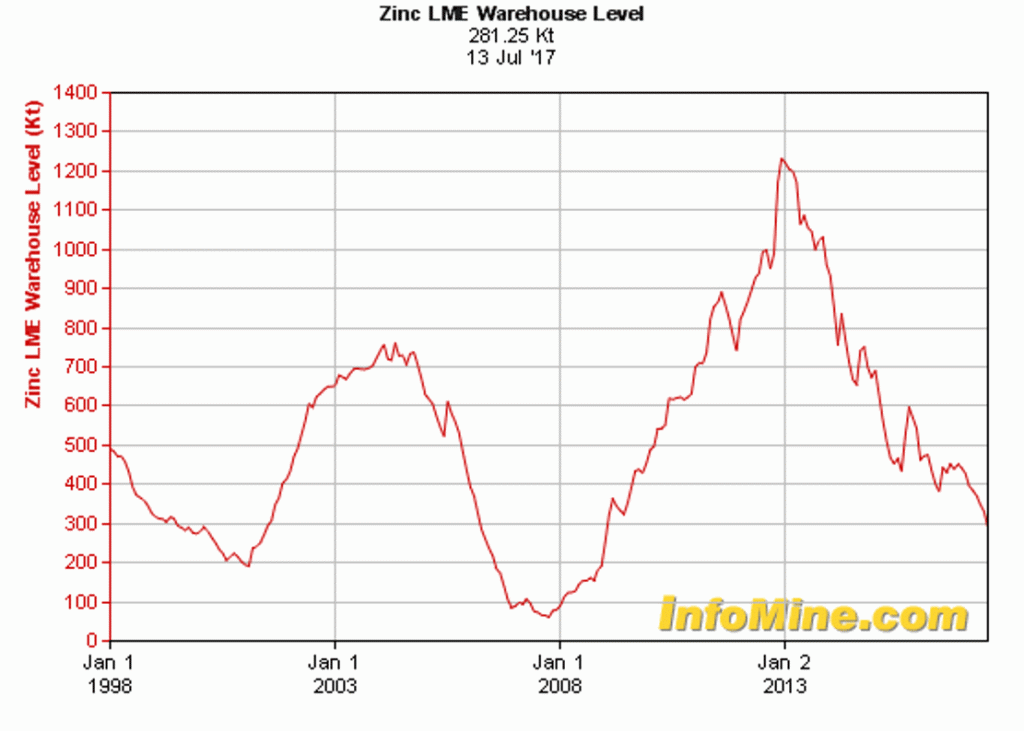The Zinc Market
Zinc has been in the news of late, with mines closing, prices rising, and stocks falling. It all looks good for potential developers and producers. However, over the last few decades zinc has often not performed as expected. The main reasons have been unexpected new sources of non-mine supply and increased production driven by higher prices. This article is a very brief review of the zinc market.
Uses
In industrial applications, zinc is primarily used for to protect other metals against corrosion. In galvanizing iron and steel, the zinc is applied either electrochemically or by hot dipping. The zinc preferentially corrodes, thus protecting the iron or steel.
Zinc is used in a variety of alloys, the most common being brass, a combination of copper and zinc. Other metals such as aluminium, titanium and magnesium are also alloyed with zinc.
The third largest use of zinc is as various compounds, particularly zinc oxide. The oxide is used as a white pigment in paint, as a catalyst, as protection from ultraviolet radiation and in hydrogen production.
All living organisms require zinc and in humans it is necessary for correct functioning of the immune system, digestion, reproduction, vision, taste and smell. Zinc deficiency is one of the leading causes of sickness and disease in developing countries.
Zinc Production and Consumption
Worldwide zinc mine production in calendar 2016 is estimated to have been 11.9 million tonnes of zinc metal, a decrease from 12.8 million tonnes in 2015. Total zinc consumption is up to 30% higher than mine production.
The difference between mine production and metal consumption is largely made up of recycled scrap and stockpiles. New scrap arises from process residues, such as castings and galvanising, and old scrap arises from recycling of products, particularly brass and alloys, at the end of their useful life.
Zinc Prices and Stocks
The chart below shows the zinc price since 1992. It is clear that a new, higher zinc price has been in place since the troubles of 2007-09. I think this is highly significant as we have an 8-year period when supply has struggled to keep up with demand. The price increase over the past year seems to mostly reflect mine closures and/or decreased production.
In common with most metals, the majority of zinc is traded privately between buyers and sellers. However, the London Metals Exchange, among others, offers a forum for metals trading by way of standardized futures and options contracts. The LME also holds stocks of various zinc brands in approved warehouses around the world.
There is a fallacy that London Metals Exchange (“LME”) stocks, and that of other exchanges, are somehow indicative of supply demand balance. They are not, they are primarily a function of financing and warehouse competition. Read more here. The primary purposes of the LME are price discovery, hedging and actual metal delivery.

Zinc Treatment Charges
When concentrate is in short supply, like now, charges fall as smelters attempt to attract sufficient concentrate. Annual smelter capacity is thought to exceed concentrate production by +1 million tonnes.
Lower treatment charges have a proportionately greater effect than higher prices, it is estimated that a USD50/tonne fall in treatment charges is equivalent to a USD100/tonne increase in the zinc price.
A consequence of the tightness of supply is that smelters and related parties are providing finance for mine development, or taking equity positions, in return for concentrate off-take agreements. A good time to be developing a zinc mine.
Conclusion
Fundamentals are looking very interesting. However, any economic slowdown will put this resurgence into hibernation. Zinc is tightly linked to economic activity; any slowdown will inevitably have a negative impact. don’t be surprised to see zinc supplies emerge “out of nowhere”, there are plenty of above ground stocks.
Coming up, a review of a few zinc stocks, where zinc is a major, but not necessarily the only, part of the portfolio. These are not necessarily the best zinc stocks, just those that appear to have good leverage against the zinc price or against project development.

